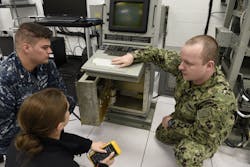Navy orders SEWIP Block 2 shipboard electronic warfare (EW) systems to defend against anti-ship missiles
WASHINGTON – U.S. Navy surface warfare experts are ordering additional advanced shipboard electronic warfare (EW) systems for surface warships like aircraft carriers, amphibious assault ships, cruisers, and destroyers under terms of a $8.8 million contract announced Monday.
Officials of the Naval Sea Systems Command in Washington are exercising options with the Lockheed Martin Corp. Rotary and Mission Systems segment in Liverpool, N.Y., to increase full-rate-production quantities of the AN/SLQ-32(V)6 Surface Electronic Warfare Improvement Program.
SEWIP Block 2 is an evolutionary acquisition and incremental development program to upgrade the existing AN/SLQ-32(V) electronic warfare system.
SEWIP provides enhanced shipboard EW for early detection, analysis, threat warning, and protection from anti-ship missiles. SEWIP Block 2 will enhance the shipboard EW systems's receiver and antenna group to meet the latest threats.
The Lockheed Martin Block 2 SEWIP design is based on its integrated common electronics warfare system (ICEWS), which enables rapid reconfiguring of the system with commercial technology.
Mercury Systems in Chelmsford, Mass., is providing advanced radio frequency (RF) microwave tuners and intermediate frequency (IF) products for SEWIP Block 2. Lockheed Martin chose the Mercury Echotek series microwave tuner and digital receiver, which are optimized for fast tuning and high performance, Mercury officials say.
Developed by Raytheon in the 1970s, the original AN/SLQ-32 shipboard systems employed passive radar technology for early warning, identification and tracking of enemy threats. Subsequent upgrades provided an additional active capability for simultaneous jamming of several different threats.
On this order Lockheed Martin will do the work in Liverpool, N.Y., and in Lansdale, Pa., and should be finished by April 2022. For more information contact Lockheed Martin Rotary and Mission Systems online at www.lockheedmartin.com, or Naval Sea Systems Command at www.navsea.navy.mil.
